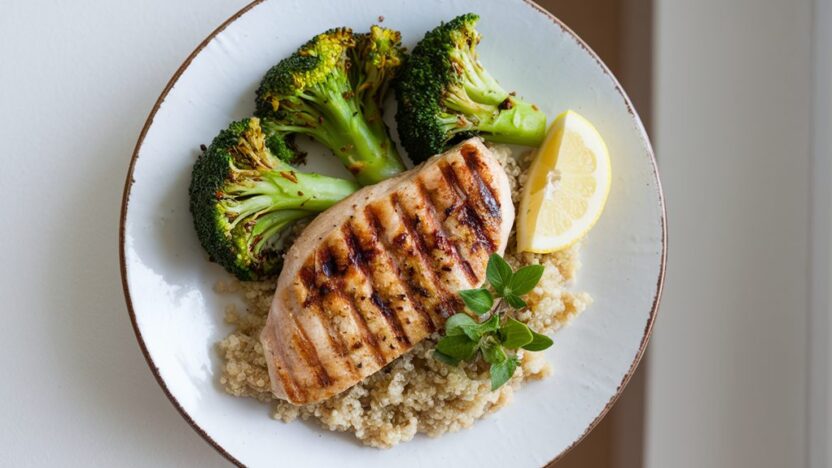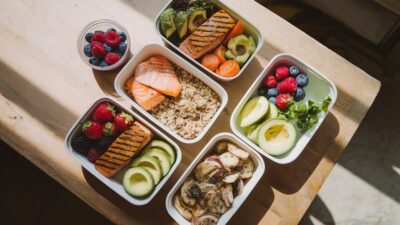Low-calorie meals don't have to be bland or boring. You'll find plenty of satisfying options, from Greek yogurt parfaits with fresh berries for breakfast to zucchini noodles with turkey bolognese for dinner. Start your day with a veggie-loaded egg white omelet (290 calories), enjoy turkey and avocado roll-ups for lunch, and finish with grilled chicken and roasted vegetables (under 400 calories) for dinner. Smart meal prep strategies, like batch cooking lean proteins and pre-chopping vegetables, make it easier to stick to your calorie goals. Proper portion control and strategic grocery shopping can transform your approach to healthy eating, opening up a world of nutritious possibilities.
Benefits of Low-Calorie Eating
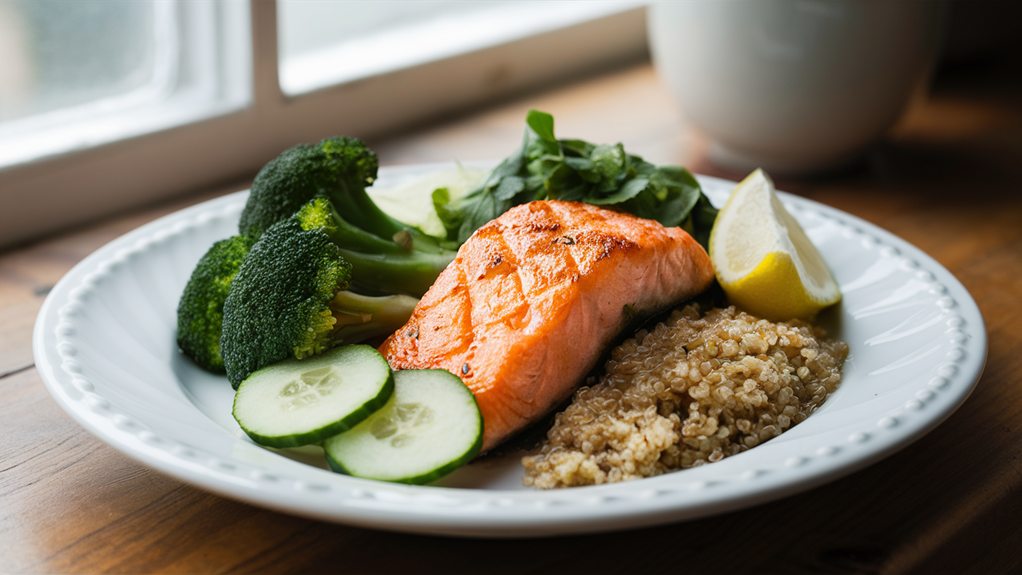
A calorie-conscious diet offers multiple proven health advantages that can transform your wellbeing. When you embrace low-calorie recipes and smart portion control, you'll notice improvements in your energy levels, mental clarity, and overall physical health.
Additionally, the benefits of incorporating a low-carb approach can enhance your results, leading to improved blood sugar control and better heart health the benefits of low-carb diets. You'll find that calorie counting becomes second nature, helping you maintain a healthy weight while still enjoying delicious meals.
By choosing low-calorie options, you're giving your body the chance to function at its best. Your digestive system won't have to work as hard, and you'll likely experience better sleep quality, improved skin health, and reduced inflammation throughout your body.
Managing portion sizes helps regulate blood sugar levels, which can lead to more stable moods and sustained energy throughout the day.
You'll discover that low-calorie eating isn't about restriction but rather about making smarter choices. When you focus on nutrient-dense foods, you'll feel satisfied with smaller portions, and your body will thank you with improved cardiovascular health, stronger bones, and enhanced immune function.
Plus, you'll develop a deeper understanding of nutrition that will serve you well throughout your life.
Smart Grocery Shopping Tips
Making those healthy, low-calorie meals begins with smart decisions at the grocery store. When you're planning your shopping trip, start by creating a detailed list that focuses on fresh, whole foods for your healthy recipes and light meals. You'll want to stick to the store's perimeter, where you'll find produce, lean proteins, and dairy products. Additionally, practicing portion control can help you understand how much of each ingredient you truly need for your meals, preventing excess purchases and waste.
Before heading to the store, follow these essential steps to guarantee success:
- Eat a satisfying meal before shopping, as hunger can lead to impulse purchases.
- Review your favorite low-calorie snacks and add their ingredients to your list.
- Check your pantry to avoid buying duplicates.
- Bring a calculator to track spending and compare unit prices.
When you're at the store, take time to read nutrition labels carefully, and don't forget to look at serving sizes.
You'll find that buying ingredients for light meals is often more cost-effective than pre-packaged options. Stock up on versatile items like vegetables, fruits, lean proteins, and whole grains that you can mix and match for various healthy recipes.
Remember to shop seasonally for the freshest produce at the best prices.
Breakfast Under 300 Calories
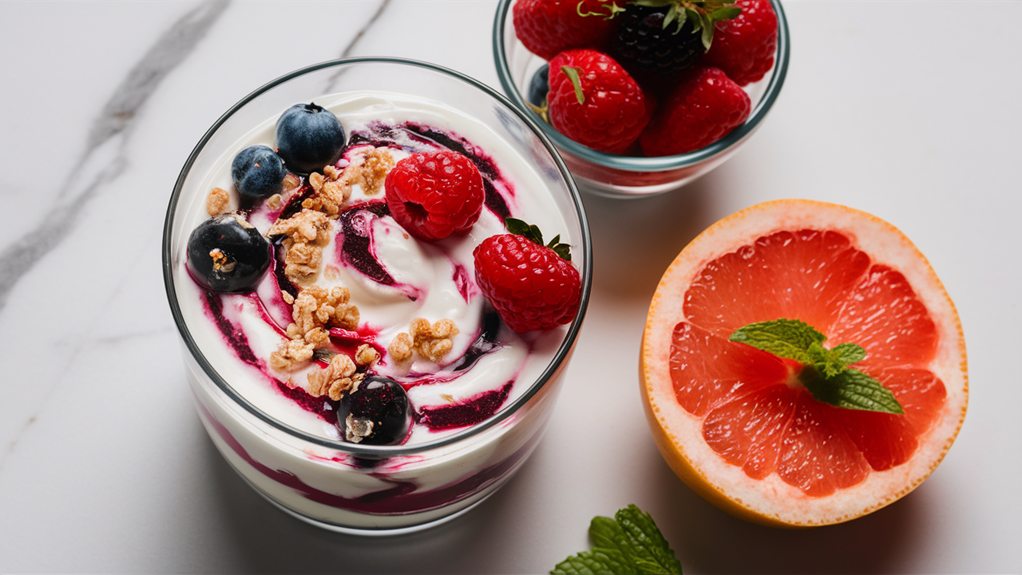
Starting your day with a nutritious breakfast doesn't mean sacrificing flavor or feeling hungry. Understanding energy balance is key to achieving your weight loss goals, and you'll find plenty of delicious options that keep you satisfied while staying under 300 calories, making it easier to maintain your health goals.
Try a protein-packed Greek yogurt parfait with fresh berries, a drizzle of honey, and a quarter cup of low-fat granola, which comes in at just 275 calories.
If you're craving something warm, whip up a veggie-loaded egg white omelet with mushrooms, spinach, and bell peppers, paired with a slice of whole-grain toast for around 290 calories.
You can also prepare overnight oats using unsweetened almond milk, chia seeds, and diced apple, topped with cinnamon and a tablespoon of chopped nuts for 265 calories.
For busy mornings, blend a filling smoothie with frozen berries, banana, spinach, and unsweetened almond milk, which provides essential nutrients at 250 calories.
Another quick option is two hard-boiled eggs with a small whole wheat English muffin and a cup of cherry tomatoes, totaling 285 calories.
Quick Lunch Ideas
When lunchtime rolls around, you'll want filling options that don't require hours in the kitchen or derail your morning's healthy momentum. Incorporating high-protein foods in your meals can enhance the importance of protein for keeping you satiated and maintaining muscle mass.
There are plenty of delicious, low-calorie options you can prepare in just minutes, keeping you satisfied until dinner without weighing you down. For a quick and nutritious lunch, try building a balanced meal with lean proteins, fresh vegetables, and moderate portions of healthy carbs.
You'll find that combining these elements creates satisfying meals that keep you energized throughout the afternoon. Here are four protein-packed options under 300 calories:
- Turkey and avocado roll-ups with cucumber slices
- Greek yogurt parfait with berries and a tablespoon of honey
- Tuna salad made with Greek yogurt instead of mayo
- Chickpea and vegetable soup with whole grain crackers
Don't forget to prep ingredients the night before, which can make your lunch assembly lightning-fast. You'll save time by washing and chopping vegetables in advance, portioning out proteins, and storing everything in grab-and-go containers.
With these strategies, you can enjoy a nutritious lunch without missing a beat in your busy schedule.
Dinner Recipes Worth Trying
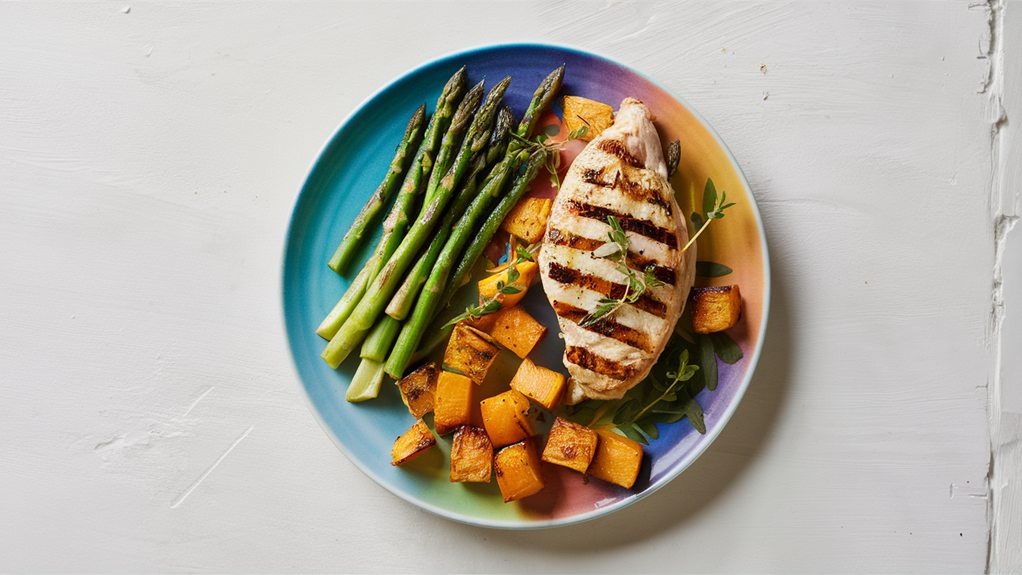
A satisfying dinner doesn't need to be calorie-heavy to be delicious and filling. You'll find plenty of ways to create nutritious evening meals that'll keep you on track with your health goals while satisfying your taste buds. Incorporating a balanced diet is essential for maintaining healthy weight management, as it guarantees you get the right nutrients while keeping your calorie intake in check.
The role of balanced diets helps you make better meal choices that support overall well-being.
Start with lean proteins like grilled chicken breast, baked fish, or turkey meatballs, which you can pair with roasted vegetables for a complete meal under 400 calories. For a vegetarian option, try cauliflower rice stir-fry with tofu, colorful bell peppers, and snap peas, seasoned with low-sodium soy sauce and ginger. You'll love how the flavors come together while keeping the calorie count low.
Don't forget about comforting classics with a healthy twist. You can make zucchini noodles with turkey bolognese sauce, or try a protein-packed quinoa bowl topped with grilled shrimp and roasted Brussels sprouts.
For those busy weeknights, sheet pan dinners are your best friend – just toss chicken breast, sweet potatoes, and broccoli with olive oil and herbs, then roast until golden. Each portion delivers plenty of nutrients while staying within your calorie goals.
Meal Prep Strategies
Successful meal preparation becomes your secret weapon for maintaining a low-calorie diet throughout the week. When you take time to plan and prep your meals in advance, you'll find it much easier to stick to your calorie goals and avoid impulsive food choices.
By dedicating just a few hours on Sunday, you can set yourself up for nutrition success and save money while doing it budget-friendly diet tips.
Start by selecting your recipes and creating a detailed shopping list that includes all your ingredients. You'll want to focus on these essential meal prep steps:
- Wash and chop all vegetables at once, storing them in clear containers
- Cook large batches of lean proteins like chicken, fish, or tofu
- Prepare whole grains and legumes in bulk quantities
- Portion everything into individual containers with correct serving sizes
Keep your prepped ingredients organized in your fridge, making it simple to assemble fresh meals quickly.
You'll find that having pre-measured portions and ready-to-go ingredients doesn't just save time – it also helps you maintain better control over your calorie intake.
Remember to label your containers with dates and contents, ensuring you're using everything while it's fresh.
Portion Control Guidelines

Proper portion control builds naturally on your meal prep efforts to maintain a low-calorie diet. Once you've prepared your healthy meals, you'll need to understand exactly how much you should be eating at each sitting, which makes measuring portions essential to your success.
You can start by using common household items as visual guides for portions. Your palm should match the size of a proper protein serving, while your cupped hand represents the right amount for grains or starches. For vegetables, you'll want two fists' worth, and your thumb can help you measure healthy fats like oils or butter.
When you're dining out, you can use these same hand measurements to gauge appropriate serving sizes.
If you're looking for more precise measurements, invest in a food scale and measuring cups. They'll help you track exactly how much you're eating, especially during your first few weeks of portion control.
Don't forget to read nutrition labels carefully, as they'll tell you the recommended serving size and help you stick to your calorie goals.
